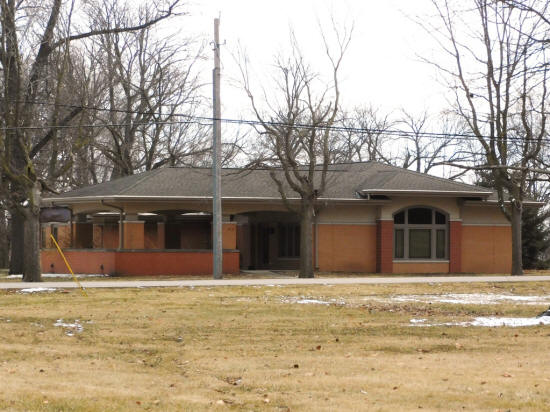|
Lincoln City Council
Illinois Department of Juvenile Justice explains plans for new
facility at former Lincoln Developmental Center in Lincoln
 Send a link to a friend
Send a link to a friend
 [February 03, 2021] [February 03, 2021]
At the Monday night meeting of the Lincoln City Council aldermen
heard from a team from the Illinois Department of Juvenile Justice.
The IDJJ has a plan that utilizes a portion of the former Lincoln
Development Center and creates jobs for local citizens.
The IDJJ team included Director Heidi Mueller and staff Michelle
Jenkins, Eva Moore, Bill Patton, Jamilah Mottley Brown and Erin
Johnson. Most of the discussion was led by Mueller with Patton
discussing some of the logistic of the plan.
The never used cottages commonly known as Lincoln Estates on the LDC
campus will be used for a juvenile detention facility, housing about
30 youth and employing approximately 50 people.
The LDC campus is owned by the state of Illinois and is managed by
the state’s Central Management Services. Originally labeled as the
“State School,” LDC opened in 1877.

The campus was shut down under the administration of Governor George
Ryan in 2002.
At that time the facility housed developmentally disabled persons
and employed more than 500 staff, most from the Lincoln and Logan
County area. Since that time, local groups such as the Lincoln Logan
County Economic Development Partnership, the city of Lincoln and a
few private organizations, all at different times, have attempted to
devise projects that would repurpose the facility.
With the IDJJ taking on only a portion of the campus, there is still
opportunity for future development of the remainder of the campus.
Mueller said that her department had sought to obtain the four
cottages along State Street for use as the detention center. In
addition, a fourth building will be constructed nearby.
It was explained that the goal of the project is to provide a
facility for youth who are from the central portion of the state.
Mueller said that right now, youth from central Illinois are being
housed in facilities throughout the state, making it difficult for
families to interact with their children while in detention.
Mueller said that her team had been seeking out a location for a
Central Illinois facility and had found the LDC campus to be a
perfect answer for their needs. She said that the residential
setting is most desirable, and that all the facilities in the state
except one in the Chicago area are in residential facilities.
Mueller said that the goal is to create a “great community
partnership” and that youth will be involved in community service
projects and other good citizen activities within their
neighborhood. She said that in all the other facilities the youth
have interacted well with the neighbors and that there have been no
issues.
Acting Mayor Tracy Welch said there were two important questions
about the plan; employment and safety.
IDJJ Chief Erin Johnson addressed those questions. She said that the
facility will utilize approximately 50 employees based on the number
utilized currently at the Grafton location, which is similar in
size.
Regarding safety, she repeated that all but one of the facilities in
service are in residential areas. Grafton is minimum security with
no fencing. In Lincoln, she said there will be some fencing, but no
barbed wire or razor wire. The Lincoln facility would be minimum to
medium security.
Johnson explained that there will be an “active security protocol”
that implements special training for staff with the goal of keeping
youth secure with less physical barriers.
Steve Parrott said he had toured the facility at Harrisburg. He
asked how the Lincoln facility would be populated, with new
detainees or with youth transferred from other facilities.
Mueller explained that most of the youth from the Central Illinois
region are being housed either in northern Illinois or at Harrisburg
(southern Illinois.) The goal is to move as many as possible to
Lincoln so they will be closer to home. She said that this will help
staff to implement family therapy programs that can help youth
transition out of the system and back home.
There will also be an aggressive mental health program at the
facility. Mueller noted that mental health is a very big issue with
many of the youth who are incarcerated and the goal will be to
address that as a priority to rehabilitation.
Mueller also explained that at the facility there will be a separate
school district for education, as well as programs for trauma
therapy and substance abuse. The facility will also have recreation
areas for outdoor exercise.
[to top of second column] |


Johnson added that the youth will also be involved in cultural activities such
as art and a dog training program. The desire is to work with local colleges to
have students spend time with the youth as role models and mentors. The
detainees will also be volunteering within the community. Mueller said that the
goal is to “invest in the community and have a positive impact.”
Sam Downs and Ron Fleshman both live near the LDC campus and serve as aldermen
for that ward. Downs said he was happy to see the IDJJ come to Lincoln and
utilize LDC. He did have to question though the plan to handle parking around
the detention center.
Bill Patton said that there is sufficient parking at each of the cottages. In
addition, when the new building is added, there will be parking included there
as well.
Downs said he wasn’t aware there was that much parking already there, but if the
state is confident then okay. Patton said the thing to keep in mind is that
while there will be up to 50 employees, those employees will be spread across
three shifts, so the need is not as great as it sounds.
Mueller added that the shift changes throughout the day will be timed so as not
to overflow into the busiest hours of the day for the community. She said that
the traffic to and from the facility will not disrupt the daily routine of the
neighbors.
Patton said that the plan is to do some land survey work for the new
construction. He invited the aldermen to reach out to him if they are interested
in visiting the facility during that process. He said all input from the local
government is welcome.
Ron Fleshman asked for clarification, the IDJJ is taking only a corner of the
LDC campus and will not be utilizing the entire space.
Patton said that was correct. He added that the buildings the IDJJ is taking are
the newer ones and in better shape than the older structures. He said the older
structures are not in nearly as good of condition, and the IDJJ just cannot take
on the task of rehabilitating those older buildings.

Parrot asked about the timeline for opening the facility and when the hiring
would begin. Mueller said that the plan was in its very beginning stages and it
is estimated that the facility will open in about two years. She said that
hiring would probably start in about a year.
Mueller explained that the state run facility will be subject to collective
bargaining agreements. As such, priority will be given first to existing
employees who wish to transfer to the Lincoln facility. When those persons have
been identified, then the balance of the staffing will be done as new hires. She
said that the IDJJ would be advertising locally for those new hires.
Jeff Hoinacki asked about the movement of detainees between buildings, how would
that be conducted.
Patton said that the facility will have fencing around the dwellings and that
movement from building to building would be with escorts.
Patton went on to say that the IDJJ plans to work closely with local police and
fire to implement various security protocols. He said the city police and fire
will have maps of the facilities, and will be involved with the “escape plans”
for the facility. He said that the IDJJ desires to work closely and openly with
local authorities and the city.
On Tuesday morning the IDJJ released a statement to the media regarding the
future of the LDC campus.
The closing paragraphs of that statement encapsulate the mission of the IDJJ at
Lincoln. “The plan is currently in Phase I of implementation; focused on
engaging external stakeholders, soliciting feedback, refining the plan, and
renovating the former Lincoln Development Center. Phase II & III, slated to
begin later this year, will continue the regional reinvestments and the official
launch of the Department’s new Community Services Division. IDJJ’s Community
Services Division focuses on providing youth with intensive, wraparound
mentoring, educational, therapeutic, and vocational support within their
communities as an alternative to incarceration where possible.”
See:
PRITZKER ADMINISTRATION ANNOUNCES NEW ILLINOIS YOUTH CENTER IN
CENTRAL ILLINOIS
The Illinois Department of Juvenile Justice will renovate former
Lincoln Development Center for its new 21st Century Illinois Transformation
Model
[Nila Smith] |